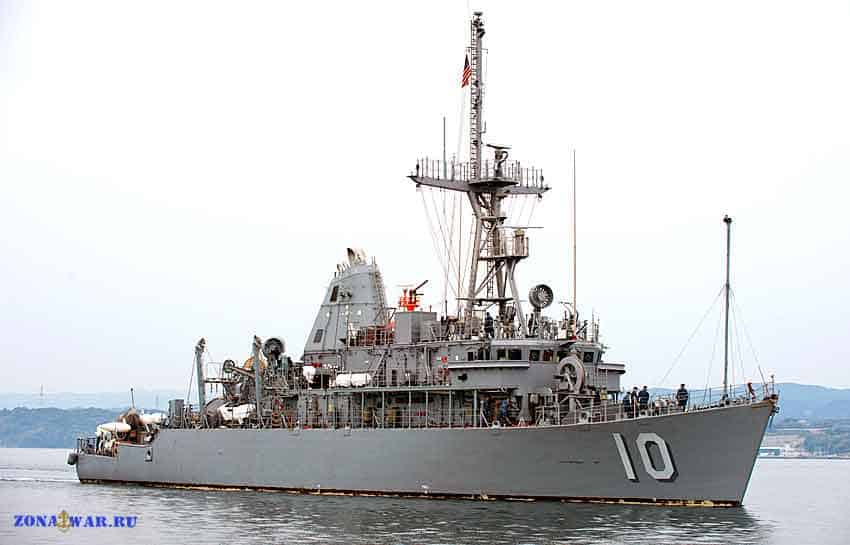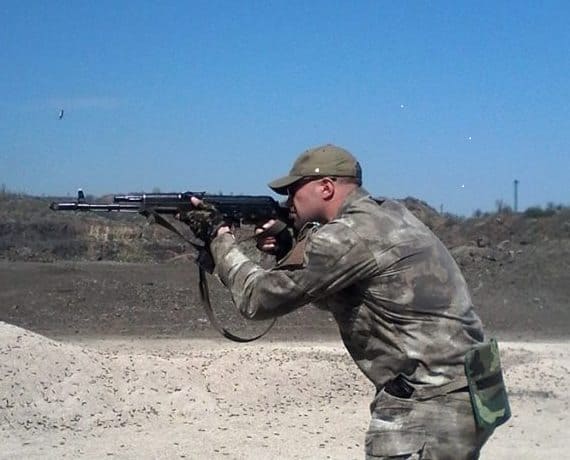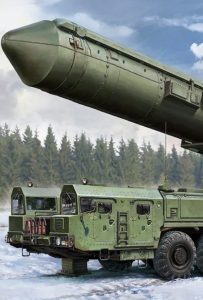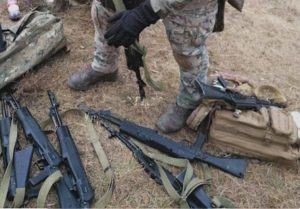By Lieutenant John Miller, U.S. Navy
Posted in U.S. Naval Institute
The U.S. Navy knows that its current adversaries pose a substantial offensive mining threat. Russia, China, and Iran each possess—and too often export—an advanced, robust, and mature offensive mine capability. The U.S. Navy must consider if it has the speed and resources with which to respond to restore freedom of maneuver in the event of sustained mining.
The pre–World War II U.S. Navy had neither built a minesweeper nor swept a mine in its history. It had zero minesweepers on the register of active ships in September 1939. In comparison, the Royal Navy had 76 fleet minesweepers. By the end of the war, more than 1,000 U.S. and Allied vessels had served as minesweepers, combating offensive mine operations from the Atlantic and the Mediterranean to the Far East. While some were purpose-built, many were commercial vessels, such as trawlers and drifters, pressed into service by the Royal Navy to support mine countermeasure (MCM), antisubmarine warfare (ASW), escort, and patrol missions. Though lightly armed, these vessels played a vital role in combating and defeating adversaries across multiple warfare domains. By filling a critical capability gap, these ships and boats enabled the Royal Navy to effectively stretch its finite naval forces across the globe.
Reflecting on mine countermeasure efforts after the war, Sir Winston Churchill wrote:
It is well to ponder this side of naval war. In the event, a significant proportion of our whole war effort had to be devoted to combating the mine. A vast output of materials and money was diverted from other tasks, and many thousands of men risked their lives night and day in the minesweepers alone.
With many calling for the revitalization of a U.S. offensive mine capability by citing the weapon’s historical efficacy (See “The Other Mine Warfare Will Work,” pp. 28–32, July 2018; and “Win with the Second Best Weapon,” pp. 60-64, November 2018), it is important not to lose sight of defensive mine warfare. Strategists and tacticians should examine the historical use of vessels of opportunity for a rapid defensive response, especially the British mine countermeasure experience in World War II. Such an approach can distribute MCM capabilities across a broader force, enabling future capacity growth and rapid innovation when required.
Present Capabilities
The Navy’s MCM force remains relevant but is aging and scarce. The 11 Avenger-class MCM ships form the surface fleet’s mine hunting and sweeping backbone. Airborne mine countermeasure capability comes from 29 MH-53E Sea Dragons. Reliability and maintenance challenges undermine the operational availability of the aging ships and airframes, and with limited numbers and wide geographic distribution, the ability to mass sufficient MCM forces during crisis is questionable at best. This makes the Navy dependent on forces such as Standing NATO Mine Countermeasures Groups 1 and 2—just eight allied vessels in Group 1 and up to six in Group 2. Thus, U.S. freedom of maneuver at sea depends on a cooperative adversary and the benevolence of our allies to offset our mine warfare shortfalls.

Enter the littoral combat ship (LCS). At times, the Navy has billed the LCS’s MCM module as a panacea for recapitalizing the minesweeping fleet, but it remains several years from full operational capability. Using a “system of systems” approach, the module fuses air, surface, and subsurface MCM sensors and weapons to prosecute mine detection and destruction. These systems include the AN/AQS-20A minehunting sonar; AN/ASQ-235 Airborne Mine Neutralization System; Airborne Laser Mine Detection System; AN/DVS-1 Coastal Battlefield Reconnaissance and Analysis; Unmanned Influence Sweep System; Knifefish unmanned undersea vehicle (UUV); and Barracuda mine neutralization system. These systems provide comprehensive, multidomain capability to mine hunt, sweep, and neutralize.
Before the emergence of the FFG(X) program, the Navy planned to buy 52 LCSs to meet its requirement for small surface combatants. As the total procurement shrank to 35 LCSs, the number of desired mission modules decreased to 44 (10 ASW, 24 MCM, and 10 surface warfare). While procurement has favored MCM modules, the Navy’s planned employment calls for a numerically balanced force of mission modules. Based on this division of labor, the force can anticipate no more than 15 MCM-capable LCSs. Because the legacy platforms in inventory are wearing out, this force does not represent a significant growth in capacity. It remains inadequate to meet more than an isolated mining incident.
The Navy continues to experiment with expeditionary mine countermeasure companies and unmanned mine hunting units as well as so-called adaptive force packages on a variety of platforms. These forces fill MCM seams for combatant commanders and demonstrate the viability of distributed, modular MCM capabilities. They also can be disaggregated into distinctive components capable of limited-scope operations. Nonetheless, when the mine problem scales, the challenge of achieving sufficient MCM mass to meet the threat remains.
Because of the Navy’s desire to stretch the utility of the MCM mission module, Congress directed the Secretary of the Navy to identify vessels of opportunity to serve as platform hosts for the nine MCM modules not earmarked for LCS. This approach makes the MCM module platform-agnostic. Conventional wisdom considers destroyers, amphibious transport docks, landing craft utilities, fleet-ocean tugs, and expeditionary mobile bases as candidates. While almost every platform could be made MCM capable, not every vessel should be. Many platforms are high-demand assets or exist only in short supply. Selection of these vessels creates an opportunity cost for the operational commander. If a guided-missile destroyer is configured for an ancillary mission such as mine countermeasures, what asset is executing its primary mission? What gap is created and what risk is incurred? The problem is not new.

Every Boat a Minesweeper
By the beginning of World War II, the Royal Navy had successfully diagnosed its shortfall in mine countermeasure capabilities, forecast the number of vessels required, and acted decisively to meet the pending danger. Because of the scale of the problem, the Royal Navy began requisitioning all forms of oceangoing vessels and activated the Royal Naval Patrol Service. Many boats traded their fishing nets and trawls for minesweeping gear. Simultaneously, the Royal Navy began activating predistributed, World War I–era, mothballed minesweepers in the United Kingdom, Singapore, and Malta. The combination of purpose-built minesweepers and vessels of opportunity provided sufficient capacity to combat the Axis mine threat.
Royal Navy reservists, comprising retired Royal Navy personnel and merchant sailors, manned the vessels alongside fishermen. While the technology was comparatively rudimentary, the crews proved adept with the sweeping gear, and civilian engineers kept myriad propulsion plants in operation. Active-duty navy ratings performed more specialized functions such as communications, signaling, and in some cases sonar (which the British called “ASDIC” at the time) or radar operation. By leveraging civilian core competencies and latent reserve capacity, the British succeeded in manning their booming growth in surface combatants. This allowed other ship classes to focus on their primary mission areas and enabled the British to provide much needed assistance to their U.S. ally.
As part of the Lend-Lease program, the Royal Navy sent liaison officers to the United States to guide construction and initial operation of U.S.-built minesweepers. In addition, the British provided 14 vessels to support both antisubmarine and mine patrols along the U.S. coast. This mutual support allowed the United States to build its own organic capacity and satiate the British demand for purpose-built minesweepers. The result yielded the American Minesweeper and the Yard Minesweeper as well as the British American Minesweeper and British Yard Minesweeper for the Royal Navy.
High-Velocity Learning
The British and Germans revolutionized World War II mine warfare through a tit-for-tat battle. The Royal Navy faced a technologically advanced, innovative adversary, who proved quite adept at asymmetric sea control and area denial.
In the beginning, the Royal Navy was prepared only to combat moored contact mines with the Oropesa cutting minesweeper. By late 1939, Hitler deployed his first “secret weapon”—the magnetic mine—from ships, E-boats, submarines, and aircraft. Initially, the British response was slow as mines claimed an increasing number of victims. The British fortuitously collected several errantly dropped German mines. In short order, scientists reverse engineered and understood the new weapon.
In rapid succession, British scientists began rolling out a variety of new technologies. Magnetic mine sweeping rigs were soon streamlined into an effective sweep called the “LL” or “Double L.” The Royal Navy also began to install degaussing coils on metal-hulled vessels, reducing the ships’ magnetic signatures to lessen susceptibility to magnetic mines.13 The British even converted the collier Borde to act as a minesweeper, installing a large supermagnet in her hull. Vickers Wellington bombers learned to fly at low altitude with a metal ring capable of carrying an induced current to detonate mines from above. This innovation represented the first airborne mine countermeasure platform. All these innovations reached initial operational capability in just a few months.
By summer 1940, the Germans began to use another secret weapon—the acoustic mine. In short succession, the British rolled out a prototype noise-making sweep, which soon evolved into the “sweep acoustic,” or “SA.” When mines became vulnerable to mine countermeasures, the Germans added delayed acoustic and magnetic fuses so that follow-on ships rather than the minesweeper forced detonation. To slow down reverse engineering and countermeasure development, the Germans also began to booby-trap mines and laid hybrid mines. Turn by turn, both countries rapidly developed and released new technologies to counter enemy innovation, although the British never developed a counter to the pressure-activated oyster mine.
This successive, rapid technological change required critical bolt-on technologies. The diverse ships of the Royal Naval Patrol Service were quite adaptable, but individual ships often proved inadequate against a range of adversary mines. By forming groups of differently capable yet relatively expendable platforms, the British managed to combat the mine threat across the globe. British and Allied minesweepers enabled expeditionary amphibious operations in North Africa, Sicily, and Normandy. They provided assured transits for convoys entering Europe, the Middle East, Russia, and the Mediterranean. Because of rapid innovation, competent manpower, and a sufficient quantity of hulls, they successfully combated the largest minefields ever constructed.
Hard-Won Lessons
The British experience provides several lessons that remain pertinent for today’s MCM force:
Keep capacity if you have it. The British maintained a reserve of World War I–era minesweepers and associated minesweeping gear. In addition, they maintained shelved MCM prototypes to combat new classes of mines. When war came, the British rapidly mobilized and fielded them. Today, the Avenger-class MCM ships should be retained in mothballs to support rapid revitalization when war threatens. Legacy mines remain a threat to the naval force; legacy countermeasure capacity remains valid. The Navy should avoid a repeat of the fire-sale scrapping of the Osprey-class minehunters in the mid-2000s. This error surrendered valuable capacity. Every MCM-capable platform is essential. Attrition in war is expected; self-impoverishment in peacetime should be avoided.

Build ally capacity and interoperability. The British provided important technical assistance to inform and guide U.S. minesweeping construction and employment. During the amphibious feint preceding Operation Desert Storm, only 7 of the 14 available coalition minesweepers were authorized to conduct wartime sweeping.18 Because similar reluctance could occur again, the United States must ensure that adequate capacity exists among multiple coalition partners to deter competitors. The MCM module should be made widely available for foreign military sales to geographically strategic allies.
Assume the adversary is keeping pace. British minesweeping technologies were highly modular but also highly specific. Each change in German mine technology required new countertechnologies. New mine types today may similarly render the MCM module inadequate. Navy researchers must examine how each component can be retooled rapidly to combat over-the-horizon mine threats. Every element of the MCM module must be designed with open architecture to allow for rapid, responsive changes.
Build a high-low MCM mix. The British used a combination of civilian and military vessels to achieve sufficient MCM capacity. Rather than devoting conventional platforms to mine warfare, the Navy should consider what non-naval vessels of opportunity could be adapted. Because the MCM module is built on remote, standoff capabilities, control vessels do not have to enter the mine threat area. With this in mind, the shocktesting and resilience demanded for legacy minesweepers is less important. Smaller, cheaper commercial hulls can be adapted to meet today’s mine warfare mission.
Grow latent MCM manning. Within the active component, the Navy scrapped its plan to have highly specialized mission-module crews. Nonetheless, the Navy should consider building and retaining MCM module expertise and competency in the reserves. Integrating active and reserve forces enables rapid mobilization. Reservists should actively participate in MCM module training, exercises, and deployments as subcomponents transition from initial to full operational capability. These trained personnel can then activate to man vessels of opportunity as required.
While few would dispute the necessity of retaining legacy airborne, surface, and subsurface countermeasure systems, this triad has long been insufficient to meet an adversary capable of a coordinated, complex, and geographically scaled offensive mine campaign. In World War II, the Royal Navy faced a similar condition. Its response demonstrates the importance of building and retaining capable crews and hulls; rapidly innovating; and institutionalizing unconventional thought. An adversary looking for critical vulnerabilities in the maritime domain would be remiss to overlook the present and near-future U.S. MCM force. The United States must fill this gap before it is exploited by a foe.
By Lieutenant John Miller, U.S. Navy
Posted in U.S. Naval Institute
SUPPORT MILITARNYI
Even a single donation or a $1 subscription will help us contnue working and developing. Fund independent military media and have access to credible information.


 Urich
Urich 
 Андрій Харук
Андрій Харук 
 Контужений Безпілотник
Контужений Безпілотник 

 Центр ініціатив ПЖ
Центр ініціатив ПЖ 



 Vadim Kushnikov
Vadim Kushnikov 
 Андрій Тарасенко
Андрій Тарасенко 
 Юрій Юзич
Юрій Юзич 
 Віктор Шолудько
Віктор Шолудько 
 Роман Приходько
Роман Приходько 



